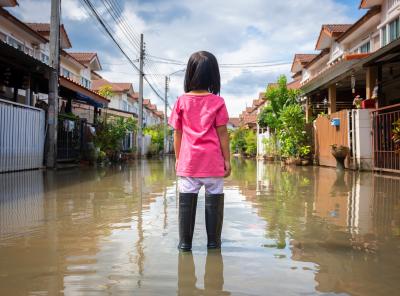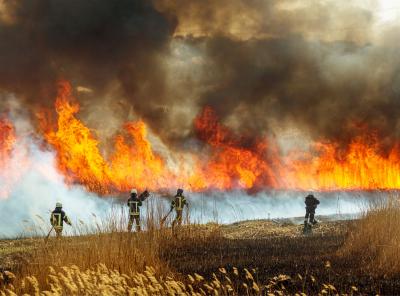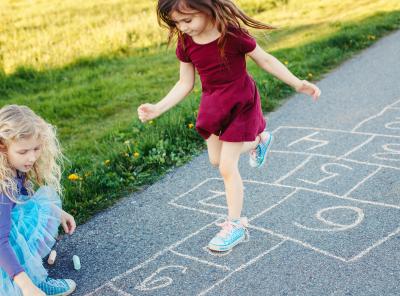Climate Change Threatens Children’s Mental Health


Climate change poses serious dangers to children’s mental health (PDF, 2.3M), research shows, with the youngest generations predicted to pay the heaviest price.
At least 14% of U.S. children experience a natural disaster (PDF, 296K), before age 18, according to the Substance Abuse and Mental Health Services Administration (SAMHSA). The number of affected children is predicted to grow dramatically in coming years, as rising global temperatures lead to more extreme weather events.
A study in Science estimates that children born in 2020 will experience two to seven times as many extreme weather events—such as hurricanes, heat waves, and wildfires—compared to people born in 1960.
Many people think of climate change as a problem for future generations, said Dr. Lindsey Burghardt, chief science officer at Harvard University’s Center on the Developing Child. But she said there is abundant evidence that children are already suffering (PDF, 2.3M) psychological harm.
Climate change is “one of the most important mental health challenges facing kids right now,” Burghardt said. “It is absolutely a health crisis.”
The danger of excessive heat
Some injuries to children’s mental health from climate disasters are life threatening.
Research has found an increased risk of suicide following disasters.
Suicide rates tend to rise in adults during hot weather, partly because excessive heat makes it harder for people to get restorative sleep, and because heat tends to make people more uncomfortable and aggressive.
Recently, doctors have documented similar trends in children. Emergency departments are seeing more young people who are thinking of suicide or who have made an attempt during hot weather, according to a study published in October. For every 1 degree Celsius (1.8 degrees Fahrenheit) increase above average daily temperatures, the number of young people ages 12 to 24 who visited emergency departments for suicidality increased by 1.3%.
A study of Australian teenagers published in 2023 also found that young people are more likely to harm themselves or consider suicide after wildfires and floods. Children who experience multiple climate disasters have even higher risks for suicidal thoughts, researchers found.
“There is a cumulative effect, so that it tends to hit you harder when you have multiple experiences” of climate-fueled disasters, said Susan Clayton, co-author of a 2023 report (PDF, 2.3M) on climate change, and children and mental health by the American Psychological Association and the advocacy groups Climate for Health and ecoAmerica. After a second disaster, more people tend to “feel helpless and pessimistic about the future.”
Many children experience significant emotional distress after a disaster, including depression, anxiety, and symptoms of post-traumatic stress, said Thomas Demaria, a psychologist at the National Center for School Crisis and Bereavement at Children’s Hospital Los Angeles. A 2021 study in JAMA Network Open found that 10% of children develop chronic symptoms of post-traumatic stress, while 23% exhibit symptoms of trauma but recover over time.
Symptoms can include loss of appetite and difficulty sleeping or concentrating (PDF, 296K). Children also may experience flashbacks or intrusive thoughts; become more irritable or aggressive; worry about dying; develop headaches and stomach aches, and other problems that interfere with their daily activities. Children also may regress to an earlier development stage (PDF, 296K) and begin wetting the bed or being afraid of the dark, Demaria said.
When young kids experience a disaster, “it affects their vision of the safety of the world,” Demaria said. “Anxiety can cause them to become more fearful. They can become hypervigilant,” he added, always imagining that another disaster is imminent.
Young minds at risk
Multiple studies, including a report from SAMHSA, show that children are at greater risk (PDF, 296K) of developing mental health disorders than adults, with the youngest being the most sensitive to environmental stress, Demaria said. Young children are vulnerable to climate disasters partly because they feel helpless. They depend on their parents and families to take care of them, cannot protect themselves, and often lack the coping skills and maturity to process frightening situations.
The most sensitive period of brain development occurs before birth, said Dr. Lindsey Burghardt, chief science officer at Harvard University’s Center on the Developing Child. “The foundations for good mental health begin in the earliest days (PDF, 2.3M) of the prenatal period,” she said.
Early exposures to environmental stress have the potential to change children’s brains. In another study, researchers who scanned the brains of children who survived Hurricane Irma, which hit Florida in 2017, found that these children had fewer cells in a part of the brain related to memory. These children also scored lower on memory tests than other children who didn’t experience the hurricane, according to the analysis—one of many important findings from the long-running Adolescent Brain Cognitive Development (ABCD) Study, a research initiative from the National Institutes of Health.
Higher temperatures and forest fires, which are being fueled by climate change, also increase the risk of preterm birth (PDF, 2.3M) said Clayton, a professor of psychology at the College of Wooster in Ohio. Babies born prematurely have heightened risks of learning problems, as well as mental disorders such as depression, bipolar disorder, and schizophrenia.
Doctors have long known that experiencing significant stress during pregnancy can increase the risk of medical complications for both mothers and babies.
Children whose mothers were pregnant during Hurricane Sandy, which caused severe damage in New York and New Jersey in 2012, were three times more likely than others to later develop attention deficit/hyperactivity disorder, five times more likely to develop anxiety, and 16 times more likely to develop depression, according to a 2022 study. In another study published in the Journal of the American Academy of Child & Adolescent Psychiatry, children whose mothers were pregnant during Hurricane Maria, which devastated Puerto Rico in 2017, were found to have lower levels of self-control than other kids.
While children are resilient, and many fully recover from the stress of natural disasters, “there’s some evidence that these early stressful events can permanently impair children’s ability to cope with serious problems,” Clayton said.
Burning questions about air quality

Like other forms of air pollution, smoke from wildfires often contains microscopic particles that can be inhaled deep into the lungs, where they can enter the bloodstream, Burghardt said. Although a membrane called the blood-brain barrier protects the brains of adults, this membrane is more porous before birth and in the first year of life. This can allow the smallest, most dangerous particles to enter the brain, causing inflammation. Scientists fear that this inflammation may cause long-term damage.
Broiling summer temperatures and wildfire smoke can harm children’s mental health in other ways, such as by making it unsafe for kids to play outside with their friends, said Harry Smolker, a research associate in psychology and neuroscience at the University of Colorado Boulder, who surveyed children participating in the ABCD Study.
Outdoor exercise and unstructured play improve children’s moods, help them sleep better and improve their concentration in school, research shows. “Play is just an essential component of childhood and an essential part of their mental health,” Burghardt said. “When you take away play, you take away the ability to build confidence, to problem solve, to do so many things that are essential to a child’s development.”
Smolker led a study, published in Environmental Health Perspectives in August, which found that children exposed to wildfire smoke were more likely to experience anxiety and depression, even a year after the fires were extinguished. Researchers found that the risk of mental illness increased with every day that children were exposed to wildfire smoke.
Smolker’s findings are bolstered by similar results from a Canadian study of 11- to 19-year-olds who were forced to evacuate their homes due to wildfires.
Researchers found increases in depression, tobacco use, and suicidal thoughts among this group, even three years later. Children who experience one or more disasters by age 5 are 15% more likely to experience depression and anxiety as adults. Children exposed to high levels of air pollution are more likely to develop schizophrenia as teens or adults.
Persistent sources of stress
Children’s hardships may persist long after a storm ends, prolonging the stress that can lead to depression and anxiety.
Families in New Orleans who were displaced by Hurricane Katrina, which flooded the city in 2005, moved an average of 3.5 times in the first nine months after the hurricane. Many students from lower-income families lost months or even years of education.
Ongoing disruptions like these can make it harder for children to recover, Demaria said, especially for families who can’t afford to rebuild their homes, replace damaged things, and pay for other expenses that could help the family return to their normal routines.
Rates of serious emotional disturbances in children in New Orleans rose from 4% before Hurricane Katrina to 15% after the storm. In follow-up surveys conducted 18 to 27 months later, nearly 12% of children still suffered from serious emotional problems.

By forcing children to change homes or schools, disasters interrupt or destroy the routines, structures, and emotional connections that help children feel safe, Demaria said. Being separated from friends, favorite teachers, and coaches can deprive children of the emotional support and stability they need to recover.
“One of the most stabilizing factors for children is a steady routine,” said Dr. Perry Sheffield, a professor of environmental medicine, climate science, and pediatrics at the Icahn School of Medicine at Mount Sinai, who is leading a study on the effect of high temperatures on children that is funded by the National Institute of Environmental Health Sciences. “As soon as a family can establish some sense of normalcy,” Sheffield said, “that tracks with mental health outcomes.”
TOPIC CLIMATE CHANGE | BY LIZ SZABO
Contact.
We love to meet like-minded people. Do you have a project you would like to chat about?